Gas Hydrate Exploration Using Deep-Towed Controlled-Source Electromagnetics in the Shenhu Area, South China Sea
Abstract
1. Introduction
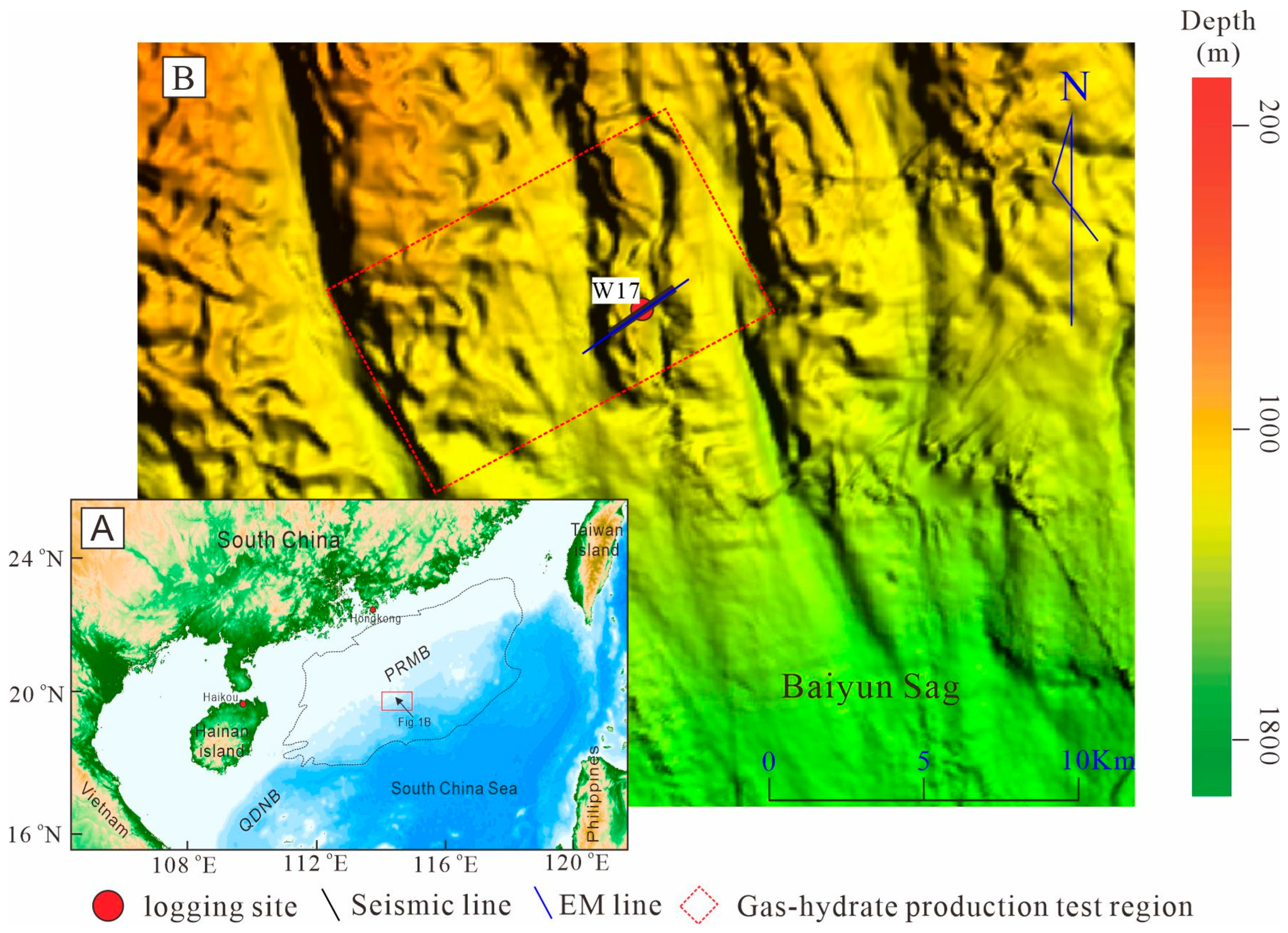
2. Geologic Setting
3. Data Acquisition
4. Data Processing and Inversion
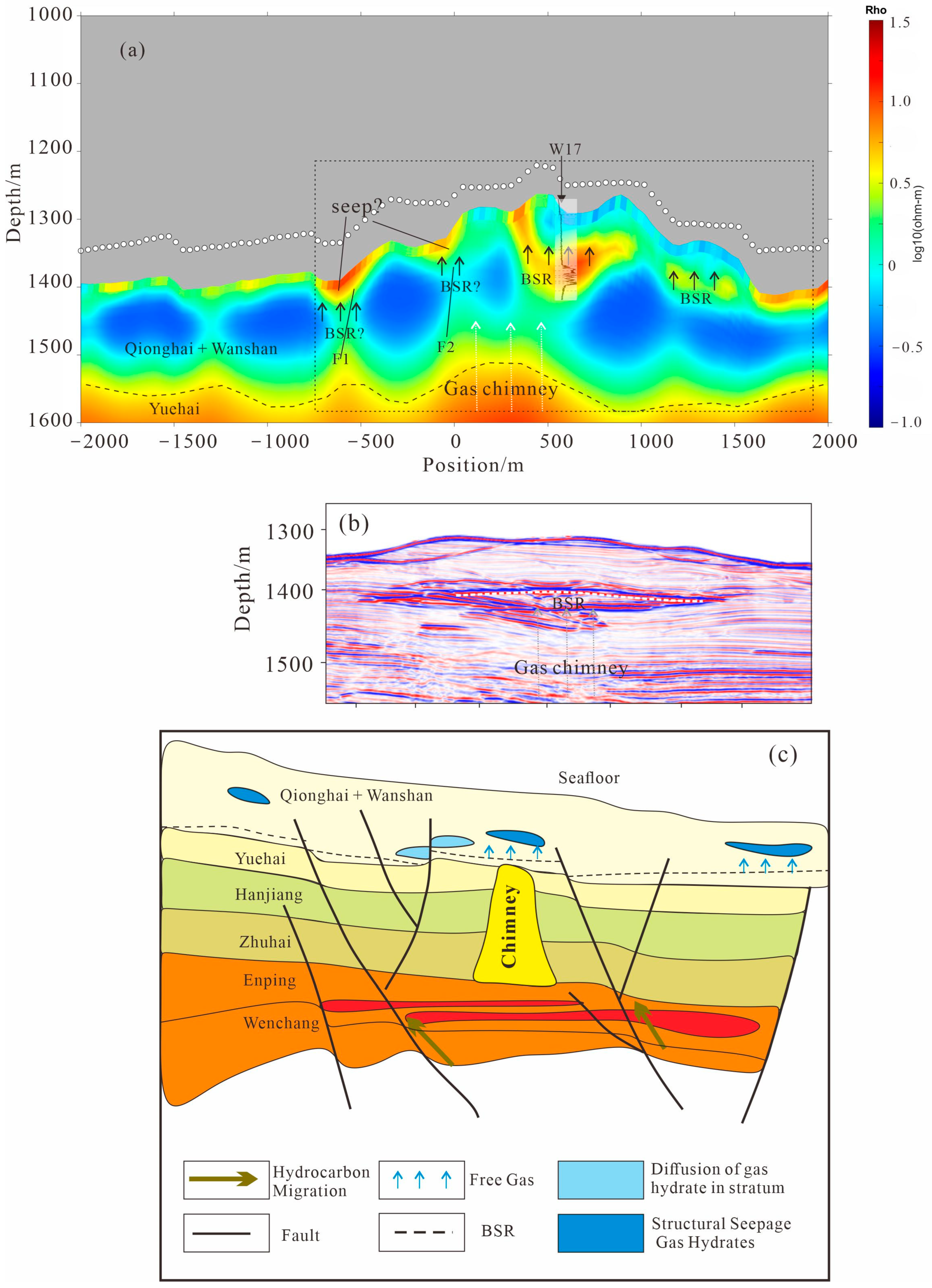
5. Discussion
6. Conclusions
Author Contributions
Funding
Data Availability Statement
Acknowledgments
Conflicts of Interest
References
- Kvenvolden, K.A. Gas Hydrates—Geological Perspective and Global Change. Rev. Geophys. 1993, 31, 173–187. [Google Scholar] [CrossRef]
- Fang, Y.; Lu, J.; Liang, J.; Kuang, Z.; Cao, Y.; Chen, D. Numerical Studies of Gas Hydrate Evolution Time in Shenhu Area in the Northern South China Sea. China Geol. 2019, 2, 49–55. [Google Scholar] [CrossRef]
- Liang, J.; Meng, M.; Liang, J.; Ren, J.; He, Y.; Li, T.; Xu, M.; Wang, X. Drilling Cores and Geophysical Characteristics of Gas Hydrate-Bearing Sediments in the Production Test Region in the Shenhu Sea, South China Sea. Front. Earth Sci. 2022, 10, 911123. [Google Scholar] [CrossRef]
- Li, J.; Ye, J.; Qin, X.; Qiu, H.; Wu, N.; Lu, H.; Xie, W.; Lu, J.; Peng, F.; Xu, Z.; et al. The First Offshore Natural Gas Hydrate Production Test in South China Sea. China Geol. 2018, 1, 5–16. [Google Scholar] [CrossRef]
- Waite, W.F.; Santamarina, J.C.; Cortes, D.D.; Dugan, B.; Espinoza, D.N.; Germaine, J.; Jang, J.; Jung, J.W.; Kneafsey, T.J.; Shin, H.; et al. Physical Properties of Hydrate-bearing Sediments. Rev. Geophys. 2009, 47, 2008RG000279. [Google Scholar] [CrossRef]
- Lu, S.; McMechan, G.A. Estimation of Gas Hydrate and Free Gas Saturation, Concentration, and Distribution from Seismic Data. Geophysics 2002, 67, 582–593. [Google Scholar] [CrossRef]
- Sloan, E.D. Fundamental Principles and Applications of Natural Gas Hydrates. Nature 2003, 426, 353–359. [Google Scholar] [CrossRef] [PubMed]
- Su, P.; Liang, J.; Peng, J.; Zhang, W.; Xu, J. Petroleum Systems Modeling on Gas Hydrate of the First Experimental Exploitation Region in the Shenhu Area, Northern South China Sea. J. Asian Earth Sci. 2018, 168, 57–76. [Google Scholar] [CrossRef]
- Zhang, W.; Liang, J.; Wei, J.; Lu, J.; Su, P.; Lin, L.; Huang, W. Origin of Natural Gases and Associated Gas Hydrates in the Shenhu Area, Northern South China Sea: Results from the China Gas Hydrate Drilling Expeditions. J. Asian Earth Sci. 2019, 183, 103953. [Google Scholar] [CrossRef]
- Zhang, W.; Liang, J.; Wei, J.; Lu, J.; Su, P.; Lin, L.; Huang, W.; Guo, Y.; Deng, W.; Yang, X.; et al. Geological and Geophysical Features of and Controls on Occurrence and Accumulation of Gas Hydrates in the First Offshore Gas-Hydrate Production Test Region in the Shenhu Area, Northern South China Sea. Mar. Pet. Geol. 2020, 114, 104191. [Google Scholar] [CrossRef]
- Zhang, W.; Liang, J.; Wan, Z.; Su, P.; Huang, W.; Lin, L. Dynamic Accumulation of Gas Hydrates Associated with the Channel-Levee System in the Shenhu Area, Northern South China Sea. Mar. Pet. Geol. 2020, 117, 104354. [Google Scholar] [CrossRef]
- Constable, S. Ten Years of Marine CSEM for Hydrocarbon Exploration. Geophysics 2010, 75, 75A67–75A81. [Google Scholar] [CrossRef]
- Constable, S. Perspectives on Marine Electromagnetic Methods. Perspect. Earth Space Sci. 2020, 1, e2019CN000123. [Google Scholar] [CrossRef]
- Constable, S.; Lu, R.; Stern, L.A.; Du Frane, W.L.; Roberts, J.J. Laboratory Electrical Conductivity of Marine Gas Hydrate. Geophys. Res. Lett. 2020, 47, e2020GL087645. [Google Scholar] [CrossRef]
- Constable, S.; Orange, A.; Myer, D. Marine Controlled-Source Electromagnetic of the Scarborough Gas Field—Part 3: Multicomponent 2D Magnetotelluric/Controlled-Source Electromagnetic Inversions. Geophysics 2019, 84, B387–B401. [Google Scholar] [CrossRef]
- Constable, S.; Srnka, L.J. An Introduction to Marine Controlled-Source Electromagnetic Methods for Hydrocarbon Exploration. Geophysics 2007, 72, WA3–WA12. [Google Scholar] [CrossRef]
- Goto, T.; Kasaya, T.; Machiyama, H.; Takagi, R.; Matsumoto, R.; Okuda, Y.; Satoh, M.; Watanabe, T.; Seama, N.; Mikada, H.; et al. A Marine Deep-Towed DC Resistivity Survey in a Methane Hydrate Area, Japan Sea. Explor. Geophys. 2008, 39, 52–59. [Google Scholar] [CrossRef]
- Evans, R.L. Using CSEM Techniques to Map the Shallow Section of Seafloor: From the Coastline to the Edges of the Continental Slope. Geophysics 2007, 72, WA105–WA116. [Google Scholar] [CrossRef]
- Gehrmann, R.A.S.; Schnabel, C.; Engels, M.; Schnabel, M.; Schwalenberg, K. Combined Interpretation of Marine Controlled Source Electromagnetic and Reflection Seismic Data in the German North Sea: A Case Study. Geophys. J. Int. 2019, 216, 218–230. [Google Scholar] [CrossRef]
- Jing, J.; Chen, K.; Deng, M.; Zhao, Q.; Luo, X.; Tu, G.; Wang, M. A Marine Controlled-Source Electromagnetic Survey to Detect Gas Hydrates in the Qiongdongnan Basin, South China Sea. J. Asian Earth Sci. 2019, 171, 201–212. [Google Scholar] [CrossRef]
- Schwalenberg, K.; Gehrmann, R.A.S.; Bialas, J.; Rippe, D. Analysis of Marine Controlled Source Electromagnetic Data for the Assessment of Gas Hydrates in the Danube Deep-Sea Fan, Black Sea. Mar. Pet. Geol. 2020, 122, 104650. [Google Scholar] [CrossRef]
- Schwalenberg, K.; Rippe, D.; Koch, S.; Scholl, C. Marine-controlled Source Electromagnetic Study of Methane Seeps and Gas Hydrates at Opouawe Bank, Hikurangi Margin, New Zealand. J. Geophys. Res. Solid Earth 2017, 122, 3334–3350. [Google Scholar] [CrossRef]
- Weitemeyer, K.A.; Constable, S.C.; Key, K.W.; Behrens, J.P. First Results from a Marine Controlled-source Electromagnetic Survey to Detect Gas Hydrates Offshore Oregon. Geophys. Res. Lett. 2006, 33, 2005GL024896. [Google Scholar] [CrossRef]
- Weitemeyer, K.A.; Constable, S.; Tréhu, A.M. A Marine Electromagnetic Survey to Detect Gas Hydrate at Hydrate Ridge, Oregon: EM at Hydrate Ridge. Geophys. J. Int. 2011, 187, 45–62. [Google Scholar] [CrossRef]
- Jing, J.E.; Wu, Z.L.; Deng, M.; Zhao, Q.X.; Luo, X.H.; Tu, G.H.; Chen, K.; Wang, M. Experiment of marine controlled source electromagnetic detection in a gas hydrate prospective region of the South China Sea. Chin. J. Geophys. 2016, 59, 2564–2572. (In Chinese) [Google Scholar] [CrossRef]
- Jing, J.E.; Zhao, Q.X.; Deng, M.; Luo, X.H.; Chen, K.; Wang, M.; Tu, G.H. A study on natural gas hydrates and their forming model using marine controlled source electromagnetic survey in the Qiongdongnan Basin. Chin. J. Geophys. 2018, 61, 4677–4689. (In Chinese) [Google Scholar] [CrossRef]
- Jing, J.E.; Zhao, Q.X.; Luo, X.H.; Liu, C.G.; Chen, K.; Wang, M.; Deng, M.; Wu, Z.L. A marine controlled-source electromagnetic imaging of gas hydrates and gas sources in the Shenhu area, South China Sea. Acta Geol. Sin. 2024, 98, 2694–2708. (In Chinese) [Google Scholar]
- Duan, S.M.; Li, Y.G.; Wu, Z.Q.; Pei, J.X. Structural imaging of marine carbonatite strata in the South Yellow Sea Basin based on marine CSEM technology. Chin. J. Geophys. 2025, 68, 1555–1566. (In Chinese) [Google Scholar] [CrossRef]
- Liu, C.; Jing, J.; Zhao, Q.; Luo, X.; Chen, K.; Wang, M.; Deng, M. High-Resolution Resistivity Imaging of a Transversely Uneven Gas Hydrate Reservoir: A Case in the Qiongdongnan Basin, South China Sea. Remote Sens. 2023, 15, 2000. [Google Scholar] [CrossRef]
- Key, K.; Constable, S. Inverted Long-Baseline Acoustic Navigation of Deep-Towed CSEM Transmitters and Receivers. Mar. Geophys. Res. 2021, 42, 6. [Google Scholar] [CrossRef]
- Constable, S.; Kannberg, P.K.; Weitemeyer, K. Vulcan: A Deep-towed CSEM Receiver. Geochem. Geophys. Geosyst. 2016, 17, 1042–1064. [Google Scholar] [CrossRef]
- Kannberg, P.K.; Constable, S. Characterization and Quantification of Gas Hydrates in the California Borderlands. Geophys. Res. Lett. 2020, 47, e2019GL084703. [Google Scholar] [CrossRef]
- King, R.B.; Constable, S. How Low Can You Go: An Investigation of Depth Sensitivity and Resolution Using Towed Marine Controlled-source Electromagnetic Systems. Geophys. Prospect. 2023, 71, 722–733. [Google Scholar] [CrossRef]
- Zhdanov, M.S.; Anderson, C.; Endo, M.; Cox, L.H.; Čuma, M.; Wilson, G.A.; Black, N.; Gribenko, A.V. 3D Inversion of Towed Streamer EM Data: A Model Study of the Harding Field with Comparison to CSEM. First Break. 2012, 30, 71–74. [Google Scholar] [CrossRef]
- King, R.B.; Constable, S.; Maloney, J.M. A Case Study in Controlled Source Electromagnetism: Near Seabed Hydrocarbon Seep Systems of Coal Oil Point, California, USA. Mar. Pet. Geol. 2022, 139, 105636. [Google Scholar] [CrossRef]
- Attias, E.; Weitemeyer, K.; Hölz, S.; Naif, S.; Minshull, T.A.; Best, A.I.; Haroon, A.; Jegen-Kulcsar, M.; Berndt, C. High-Resolution Resistivity Imaging of Marine Gas Hydrate Structures by Combined Inversion of CSEM Towed and Ocean-Bottom Receiver Data. Geophys. J. Int. 2018, 214, 1701–1714. [Google Scholar] [CrossRef]
- Sherman, D.; Kannberg, P.; Constable, S. Surface Towed Electromagnetic System for Mapping of Subsea Arctic Permafrost. Earth Planet. Sci. Lett. 2017, 460, 97–104. [Google Scholar] [CrossRef]
- Attias, E.; Constable, S.; Sherman, D.; Ismail, K.; Shuler, C.; Dulai, H. Marine Electromagnetic Imaging and Volumetric Estimation of Freshwater Plumes Offshore Hawai’i. Geophys. Res. Lett. 2021, 48, e2020GL091249. [Google Scholar] [CrossRef]
- Micallef, A.; Person, M.; Haroon, A.; Weymer, B.A.; Jegen, M.; Schwalenberg, K.; Faghih, Z.; Duan, S.; Cohen, D.; Mountjoy, J.J.; et al. 3D Characterisation and Quantification of an Offshore Freshened Groundwater System in the Canterbury Bight. Nat. Commun. 2020, 11, 1372. [Google Scholar] [CrossRef]
- Liang, J.; Zhang, Z.; Su, P.; Sha, Z.; Yang, S. Evaluation of Gas Hydrate-Bearing Sediments below the Conventional Bottom-Simulating Reflection on the Northern Slope of the South China Sea. Interpretation 2017, 5, SM61–SM74. [Google Scholar] [CrossRef]
- Wang, M.; Deng, M.; Wu, Z.; Luo, X.; Jing, J.; Chen, K. The Deep-Tow Marine Controlled-Source Electromagnetic Transmitter System for Gas Hydrate Exploration. J. Appl. Geophys. 2017, 137, 138–144. [Google Scholar] [CrossRef]
- Wang, M.; Wu, Z.L.; Yu, P.; Deng, M.; Ren, Z.B.; Wang, C.T. 2000A class marine controlled source electromagnetic transmitter system. Chin. J. Geophys. 2024, 67, 4482–4492. (In Chinese) [Google Scholar] [CrossRef]
- Wang, M.; Deng, M.; Yu, P.; Yin, C.C.; Chen, K.; Luo, X.H. High-power time-frequency transmission and multi-chain cable multi-componentelectromagnetic system for deeprwater exploration. Chin. J. Geophys. 2022, 65, 3664–3673. [Google Scholar] [CrossRef]
- Chen, K.; Jing, J.E.; Zhao, Q.X.; Luo, X.H.; Tu, G.H.; Wang, M. Ocean bottom EM receiver and application for gas hydrate detection. Chin. J. Geophys. 2017, 60, 4262–4272. (In Chinese) [Google Scholar] [CrossRef]
- Myer, D.; Constable, S.; Key, K. Broad-Band Waveforms and Robust Processing for Marine CSEM Surveys: CSEM Waveforms and Processing. Geophys. J. Int. 2011, 184, 689–698. [Google Scholar] [CrossRef]
- Li, Y.G.; Duan, S.M. Data Preprocessing of Marine Control led—Source Electromagnetic Data. Period. Ocean Univ. China 2014, 44, 106–112. (In Chinese) [Google Scholar] [CrossRef]
- Key, K. MARE2DEM: A 2-D Inversion Code for Controlled-Source Electromagnetic and Magnetotelluric Data. Geophys. J. Int. 2016, 207, 571–588. [Google Scholar] [CrossRef]
- Li, Y.; Key, K. 2D Marine Controlled-Source Electromagnetic Modeling: Part 1—An Adaptive Finite-Element Algorithm. Geophysics 2007, 72, WA51–WA62. [Google Scholar] [CrossRef]
- Key, K. 1D Inversion of Multicomponent, Multifrequency Marine CSEM Data: Methodology and Synthetic Studies for Resolving Thin Resistive Layers. Geophysics 2009, 74, F9–F20. [Google Scholar] [CrossRef]
- Tinivella, U.; Carcione, J.M. Estimation of Gas-Hydrate Concentration and Free-Gas Saturation from Log and Seismic Data. Lead. Edge 2001, 20, 200–203. [Google Scholar] [CrossRef]
- Yang, S.X.; Liang, J.Q.; Lu, J.A.; Qu, C.W.; Liu, B. New understandings on the characteristics and controlling factors of gas hydrate reservoirs in the Shenhu area on the northern slope of the South China Sea. Earth Sci. Front. 2017, 24, 1–14. (In Chinese) [Google Scholar]
- Wang, X.; Wu, S.; Guo, Y.; Yang, S.; Gong, Y. Geophysical Indicators of Gas Hydrate in the Northern Continental Margin, South China Sea. J. Geol. Res. 2011, 2011, 359597. [Google Scholar] [CrossRef]
- Archie, G.E. The Electrical Resistivity Log as an Aid in Determining Some Reservoir Characteristics. Trans. AIME 1942, 146, 54–62. [Google Scholar] [CrossRef]
- Collett, T.S.; Ladd, J. 19. Detection of gas hydrate with downhole logs and assessment of gas hydrate concentrations (saturations) and gas volumes on the Blake Ridge with electrically resistivity log data. In Proceedings of the Ocean Drilling Program, Scientific Results, College Station, TX, USA, 12 June 2000; Volume 164. [Google Scholar]
- Kang, D.; Lu, J.; Zhang, Z.; Liang, J.; Kuang, Z.; Lu, C.; Kou, B.; Lu, Q.; Wang, J. Fine-Grained Gas Hydrate Reservoir Properties Estimated from Well Logs and Lab Measurements at the Shenhu Gas Hydrate Production Test Site, the Northern Slope of the South China Sea. Mar. Pet. Geol. 2020, 122, 104676. [Google Scholar] [CrossRef]
- Liu, T.; Liu, X.; Zhu, T. Joint Analysis of P-Wave Velocity and Resistivity for Morphology Identification and Quantification of Gas Hydrate. Mar. Pet. Geol. 2020, 112, 104036. [Google Scholar] [CrossRef]
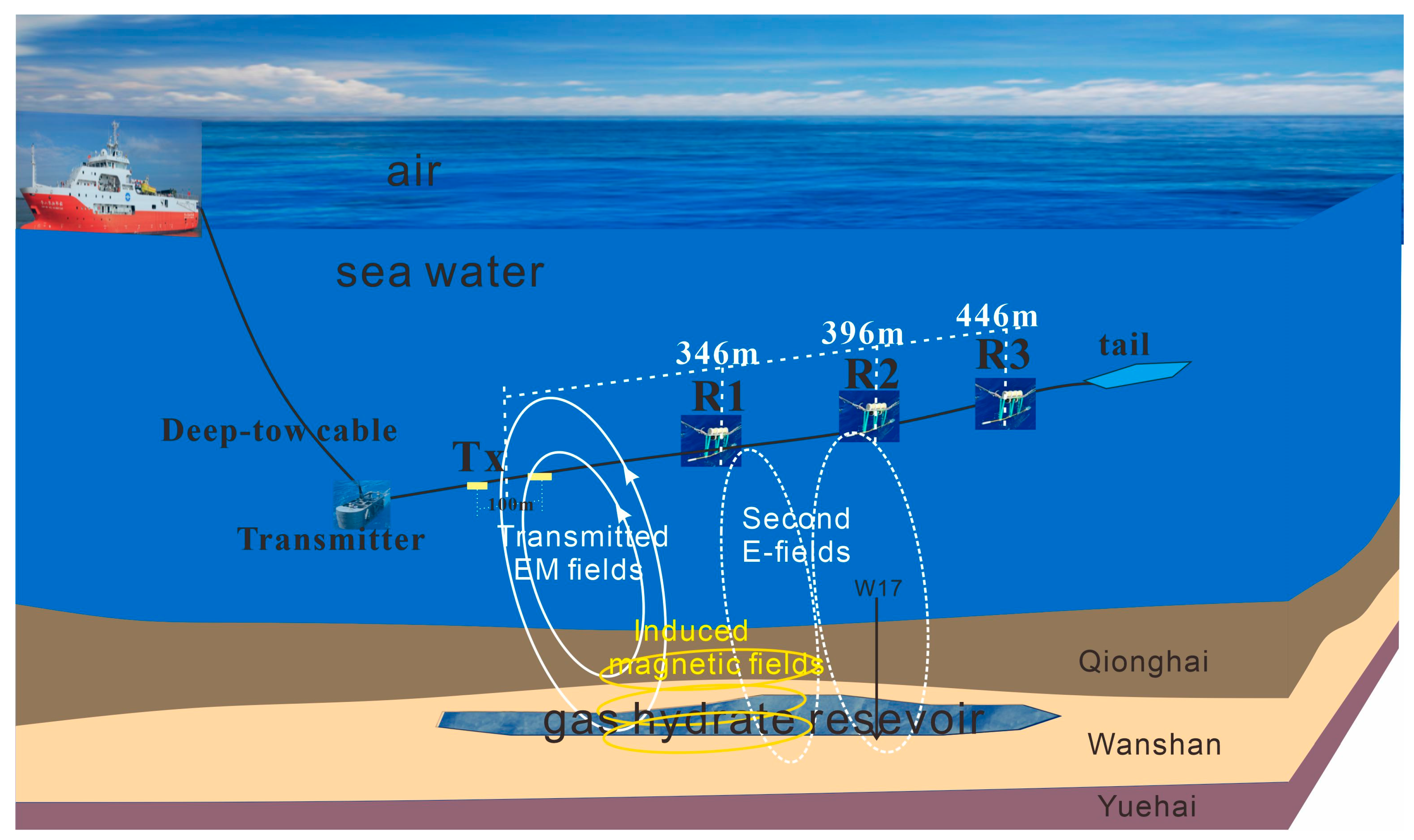
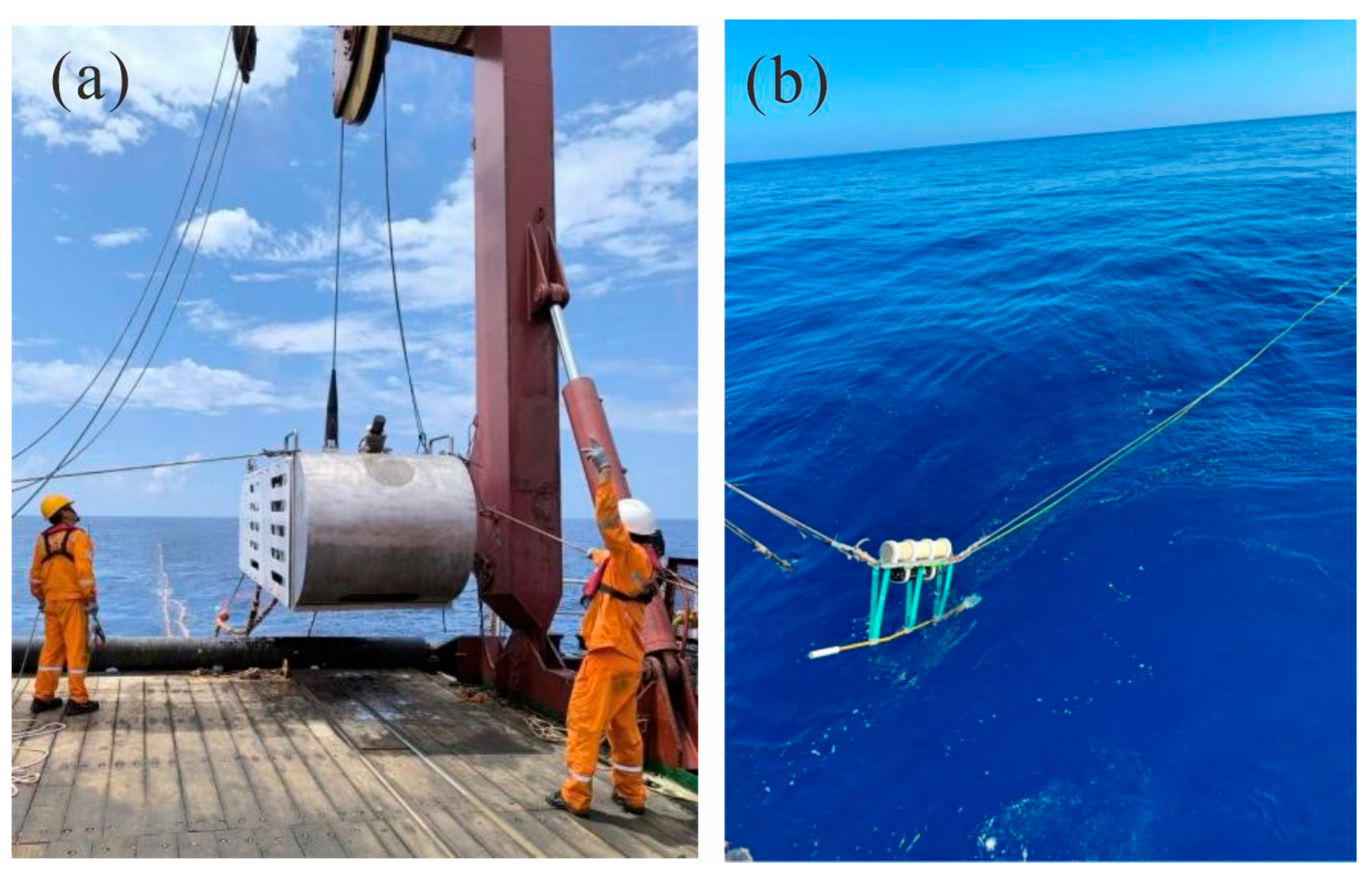
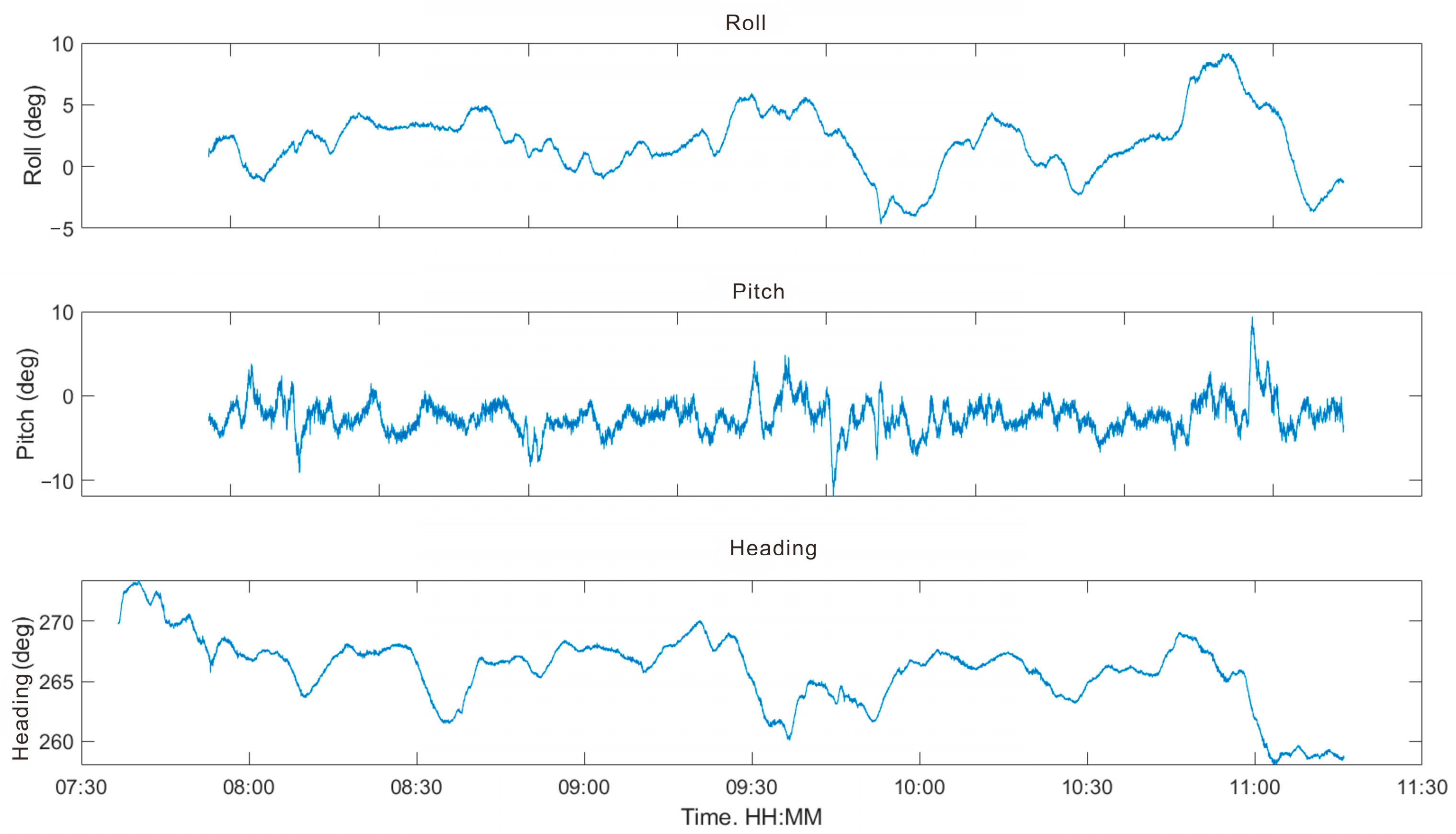
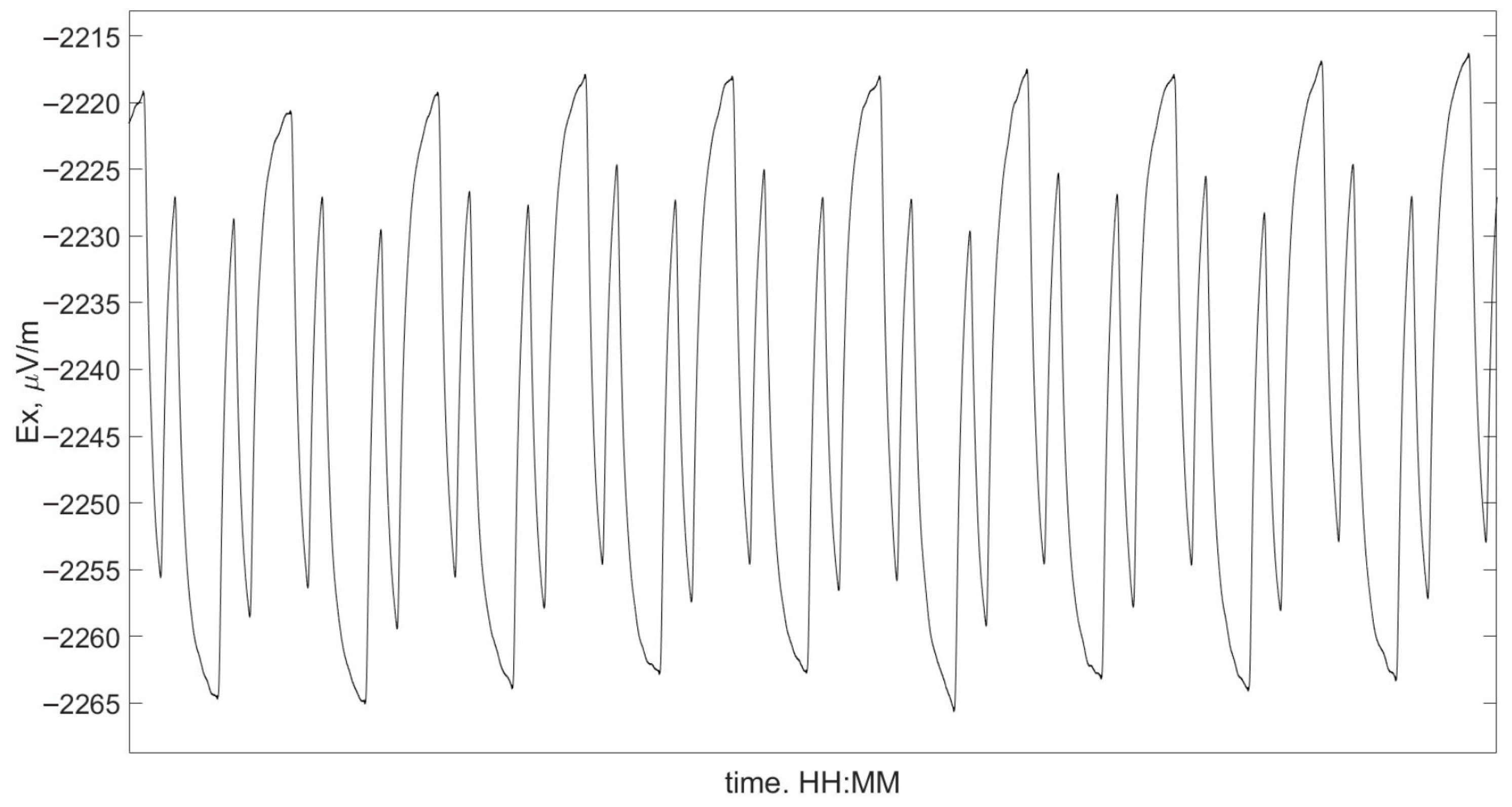
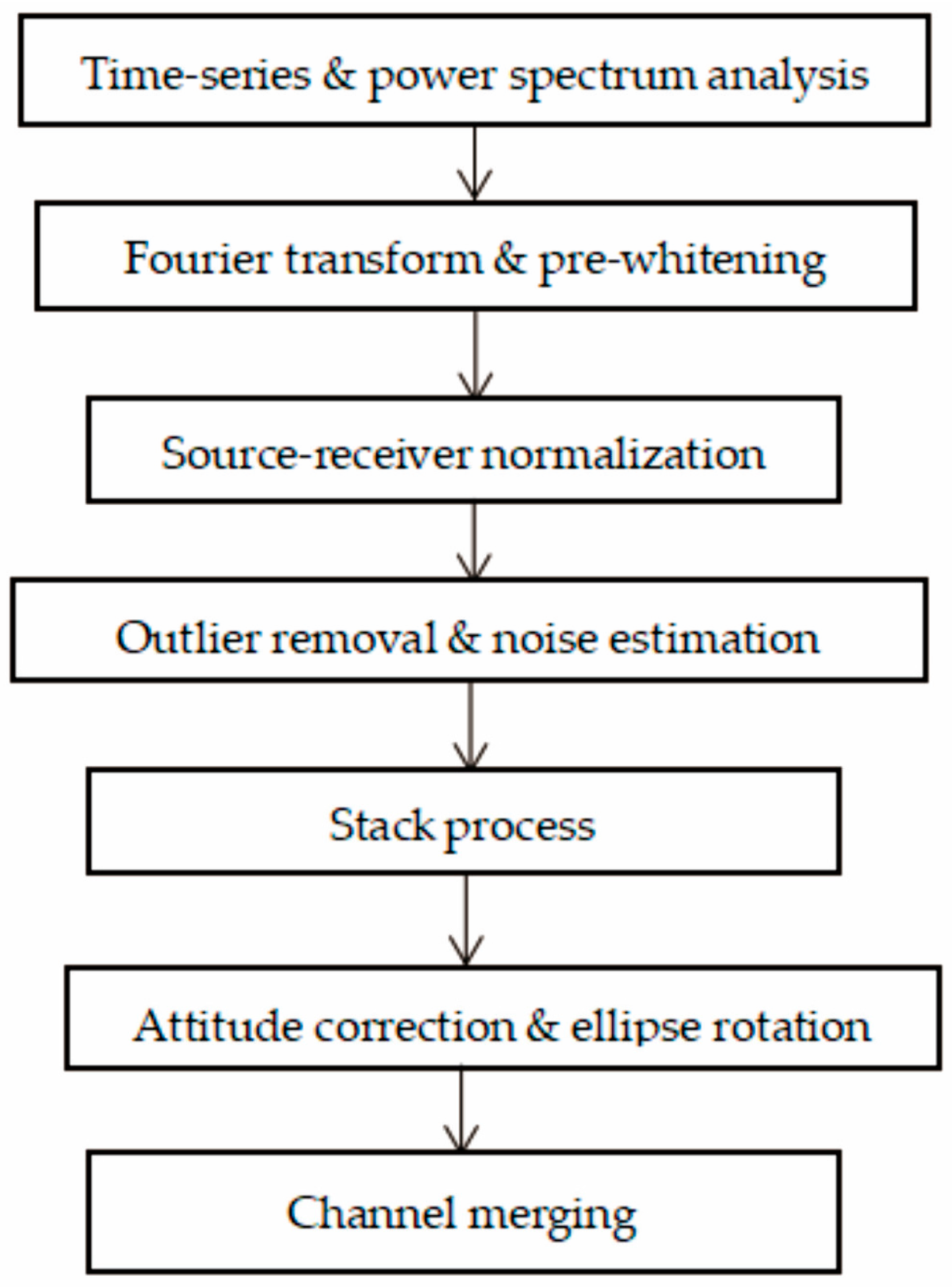
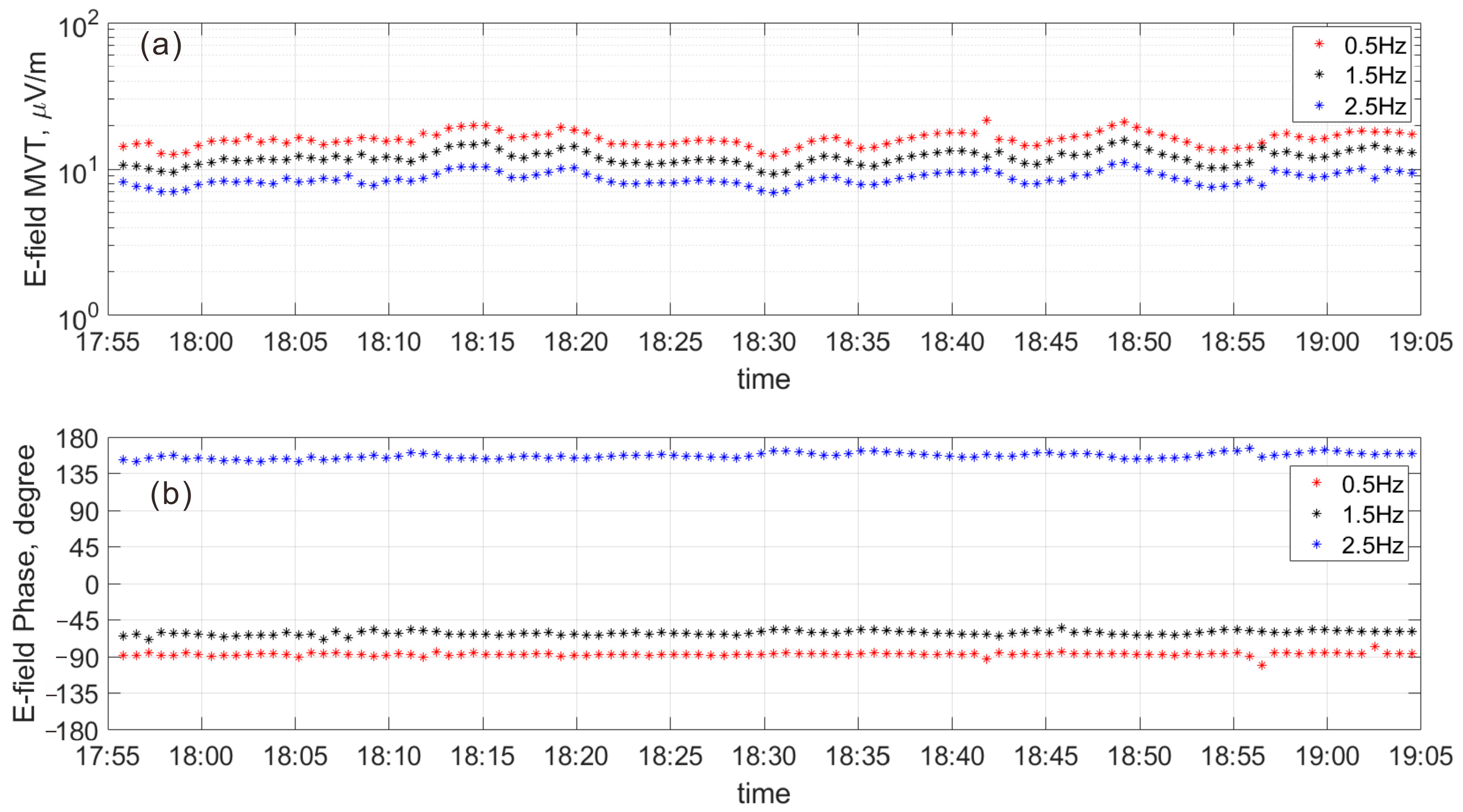




Disclaimer/Publisher’s Note: The statements, opinions and data contained in all publications are solely those of the individual author(s) and contributor(s) and not of MDPI and/or the editor(s). MDPI and/or the editor(s) disclaim responsibility for any injury to people or property resulting from any ideas, methods, instructions or products referred to in the content. |
© 2025 by the authors. Licensee MDPI, Basel, Switzerland. This article is an open access article distributed under the terms and conditions of the Creative Commons Attribution (CC BY) license (https://creativecommons.org/licenses/by/4.0/).
Share and Cite
Li, J.; Wu, Z.; Chen, X.; Jing, J.; Yu, P.; Luo, X.; Wen, M.; Su, P.; Chen, K.; Wang, M.; et al. Gas Hydrate Exploration Using Deep-Towed Controlled-Source Electromagnetics in the Shenhu Area, South China Sea. J. Mar. Sci. Eng. 2025, 13, 1665. https://doi.org/10.3390/jmse13091665
Li J, Wu Z, Chen X, Jing J, Yu P, Luo X, Wen M, Su P, Chen K, Wang M, et al. Gas Hydrate Exploration Using Deep-Towed Controlled-Source Electromagnetics in the Shenhu Area, South China Sea. Journal of Marine Science and Engineering. 2025; 13(9):1665. https://doi.org/10.3390/jmse13091665
Chicago/Turabian StyleLi, Jianping, Zhongliang Wu, Xi Chen, Jian’en Jing, Ping Yu, Xianhu Luo, Mingming Wen, Pibo Su, Kai Chen, Meng Wang, and et al. 2025. "Gas Hydrate Exploration Using Deep-Towed Controlled-Source Electromagnetics in the Shenhu Area, South China Sea" Journal of Marine Science and Engineering 13, no. 9: 1665. https://doi.org/10.3390/jmse13091665
APA StyleLi, J., Wu, Z., Chen, X., Jing, J., Yu, P., Luo, X., Wen, M., Su, P., Chen, K., Wang, M., Gao, Y., & Zhang, Y. (2025). Gas Hydrate Exploration Using Deep-Towed Controlled-Source Electromagnetics in the Shenhu Area, South China Sea. Journal of Marine Science and Engineering, 13(9), 1665. https://doi.org/10.3390/jmse13091665







